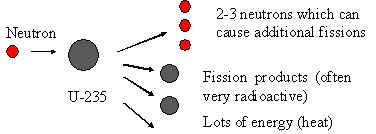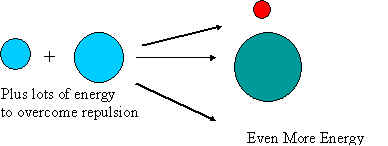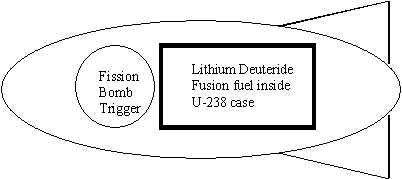Time Travel Research Center © 2005 Cetin BAL - GSM:+90 05366063183 - Turkey/Denizli
Fission and Fusion
Recall that the basic nuclear reaction involved in both an atomic bomb and a nuclear power plant is nuclear fission:
 |
Nuclear Fusion. In a nuclear fusion reaction two light nuclei are joined together to produce one larger nucleus. Fusion converts a larger percentage of the mass-energy of the reactants into heat than does fission.
Example of a fusion reaction:
 |
Recall that the nucleus is made of positively charged protons and neutral neutrons. The protons repel each other (Coulombic repulsion), but the nuclear strong force overcomes this repulsion to hold the nucleus together. In order to get fusion to work you have to get the two smaller nuclei close enough together for the nuclear strong force to take over. But that requires an enormous amount of energy to overcome the Coulombic repulsion.
History of the hydrogen fusion bomb.
- The basic idea apparently originated with Enrico Fermi at Chicago in 1941.
- Fermi asked Edward Teller about the feasibility of using a fission bomb to produce the energy required to overcome the Coloumbic repulsion and set off a fusion reaction. (fission bomb as a trigger).
- Teller became - well - obsessed with the idea.
- Work took on a new urgency when Soviets tested a fission bomb in 1949.
- Work began in earnest in early 50s and first crude device exploded in 1952.
A Superbomb...
- The first fusion bomb yielded a ten megaton explosion (>1000 Hiroshima bombs).
- This bomb occupied a building and weighed 62 tons.
- It vaporized a small Pacific island (Elugelab) leaving behind a two mile wide and half mile deep crater.
- Within a few years both the US and Soviets were able to field weapons yielding more than 20 megatons which could be carried by bombers and by missiles launched from ground and submarines.
- In addition, new technology allowed production of much smaller yield weapons which could even be fired by artillery.
Construction of a fusion bomb (the Teller-Ulam design)
 |
Very simplified
Hydrogen Fusion Bomb (Teller-Ulam design) |
- The explosion of the fission trigger heats and compresses the lithium deuteride fusion fuel.
- The neutrons produced by the fission trigger convert lithium to tritium.
- Deuterium-tritium fusion results and produces lots of energy.
- In addition, the neutrons produced by the fusion reaction cause additional fissions in the U-238 producing more energy. Fusion and fission contribute about equal amounts of energy to the explosion.
- Dont you need U-235 for fission? For a chain reaction you need U-235, but here the high speed neutrons split U-238.
Thus the fusion bomb is really a fission-fusion-fission bomb that releases enormous amounts of energy. Note that the fusion process itself is relatively clean, but the fission trigger and fissions in the case that holds the fusion fuel produce lots of radioactive isotopes.
Hiçbir yazı/ resim izinsiz olarak kullanılamaz!! Telif hakları uyarınca bu bir suçtur..! Tüm hakları Çetin BAL' a aittir. Kaynak gösterilmek şartıyla siteden alıntı yapılabilir.
The Time Machine Project © 2005 Cetin BAL - GSM:+90 05366063183 -Turkiye/Denizli
Ana Sayfa /İndex /Roket bilimi / ![]() E-Mail /CetinBAL /Quantum Teleportation-2
E-Mail /CetinBAL /Quantum Teleportation-2
Time Travel Technology /Ziyaretçi Defteri / Duyuru / UFO Technology